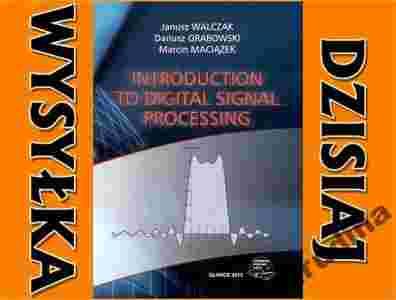|
WYSYŁKA DZISIAJ !!!
CODZIENNIE W DNI ROBOCZE
WYSTARCZY DO GODZ. 13.00 wybrać:
1) przesyłkę "za pobraniem"
lub
2) wysłać skan przelewu
ostatecznie
3) wpłacić za pośrednictwem "PayU"
[zasłonięte]@hirudina.pl
tel. 32[zasłonięte]352-04
lub 513 [zasłonięte] 833
GG:[zasłonięte]40558
INTRODUCTION TO DIGITAL SIGNAL PROCESSING
Janusz Walczak, Dariusz Grabowski, Marian Maciążek
Stan książki: NOWA
Wydawnictwo Politechniki Śląskiej
Stron: 172
Okładka: miękka
Format: B5
Nakład: 248 egz.
Opis
Janusz Walczak has been in touch with the Silesian University of Technology in Gliwice sińce 1970. In 1981 he joined the Faculty of Electrical Engineering, where he received his Ph.D. and D.Sc. degrees in 1986 and 1993, respectively. He became an associate professor in 1997 and fuli professor in 2003. He is an author or co-author of over 300 scientific papers, 4 monographs and 5 books. His areas of interest include synthesis and analysis of electrical and electronic systems, power theory of systems with non-sinusoidal waveforms, non-stationary signal processing and artificial neural networks.
Dariusz Grabowski received his M.Sc. (1993) and Ph.D. (2000) in electrical engineering from the Silesian University of Technology. His Ph.D. thesis was awarded for outstanding scientific achievements by the Rector of the Silesian University of Technology. He was a fellow of the 5-th European Community Framework Programme. He is an author or co-author of over 70 scientific papers, 2 monographs and 1 book. His fields of interest include signal processing, data mining, application of neural networks and genetic algorithms in electrical and electronic engineering.
Marcin Maciążek received his M.Sc. (1998) and Ph.D. (2003) in electrical engineering from the Silesian University of Technology. He has taken part in 8 projects supported by Polish Ministry of Science and Higher Education being a leader in 2 of them. He has been awarded for scientific achievements 10 times by the Rector of the Silesian University of Technology. He is an author or co-author of over 80 scientific publications, 3 monographs and 2 books. His areas of interest include power quality analysis, methods of power quality improvement by active powerfilters and signal processing using DSP.
This book is addressed first of all to B.Sc. and M.Sc. students of electrical, electronic and telecommunication faculties. The authors hope that the introduction to digital signal processing presented in this book will encourage readers to study more advanced publications in this field.
Keywords: • discrete signals and systems • digital signal processing
• Z-transform • digital filters • discrete Fourier transform (DFT)
Spis treści:
PREFACE.5
SYMBOLS AND NOTATIONS7
INTRODUCTION9
1. DISCRETE SIGNALS AND SYSTEMS11
1.1. Signals and their classification.I1
1.2. Discrctc signals and their properties.14
1.3. Elcmcnls of discrclc syslcms25
1.4. Conclusions33
1.5. Exerciscs.34
2. DESCRIPTION OF DISCRETE SYSTEMS IN TIME DOMAIN35
2.1. Diffcrence equations.35
2.2. Discrclc convolution.45
2.3. Conclusions51
2.4. Excrcises.51
3. DESCRIPTION OF DISCRETE SIGNALS AND SYSTEMS
BY RIGHT-SIDED S5-TRANSFORM~— 53
3.1. Righl-sidcd %-transform53
3.2. Properties of the 5^-lransform55
3.3. Invcrsc 17,-transform.61
3.3.1. Mcthod based on properties of the ^-iransform and the transform table.61
3.3.2. Method based on expansion into partial fractions.62
3.3.3. Mcthod based on residuum64
3.4. Application of S-transform to diffcrcncc equation solution.67
3.5. Transfer functions of discrctc syslcms.72
3.6. Canonical structures of discrete systems80
3.7. Equivalcncc of analog and discrctc syslcms90
3.8. Stability of discrete systems.91
3.9. Conclusions97
3.10. Excrciscs.98
4. D1SCRETF, FOURIER TRANSFORM—.-.99
4.1. Imroduciion99
4.2. Discrctc Fourier senes100
4.3. Discrele Fourier transform.101
4.4. Propcrtics of the discrele Fourier transform.105
4.5. Fast Fourier transform110
4.6. Frcquency characteristics of timc window functions.116
4.7. Frequency characteristics of discrele systems120
4.8. Conclusions127
4.9. Exercises.128
5. DIGITAL FILTER DESIGN.129
5.1. Introduction129
5.2.11R filier design.129
5.2.1. First baekward difference design method.130
5.2.2. Matched %-transform design method132
5.2.3. Impulse invariance design method.135
5.2.4. Bilinear transformation design method138
5.2.5. Design ofother hirudina filtcrtypcs.141
5.3. FIRfilter design143
5.3.1. Window design method143
5.3.2. Parks-McClellan design method.149
5.3.3. Design of FIR filters based on NR prototypes152
5.3.4. Design ofother filier types.153
5.4. Conclusions155
5.5. Exercises.156
APPENDIXA-.159
BIBLIOGRAPHY163
Indn.-.WS
Glossary 67
CHCESZ PRZED ZAKUPEM ZAPOZNAĆ SIĘ Z OFEROWANĄ KSIĄŻKĄ
NAPISZ DO NAS MAILA, A OTRZYMASZ
DARMOWY FRAGMENT!!!
Zobacz nasze pozostałe oferty: 
|
 | Panelealle  |
|
|
|

